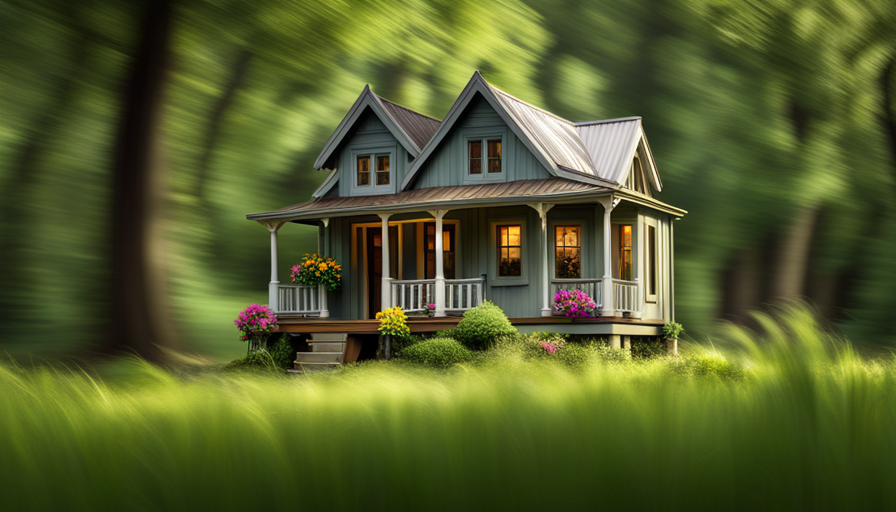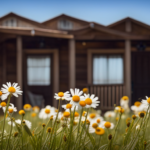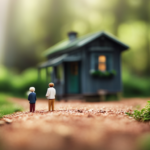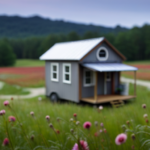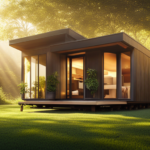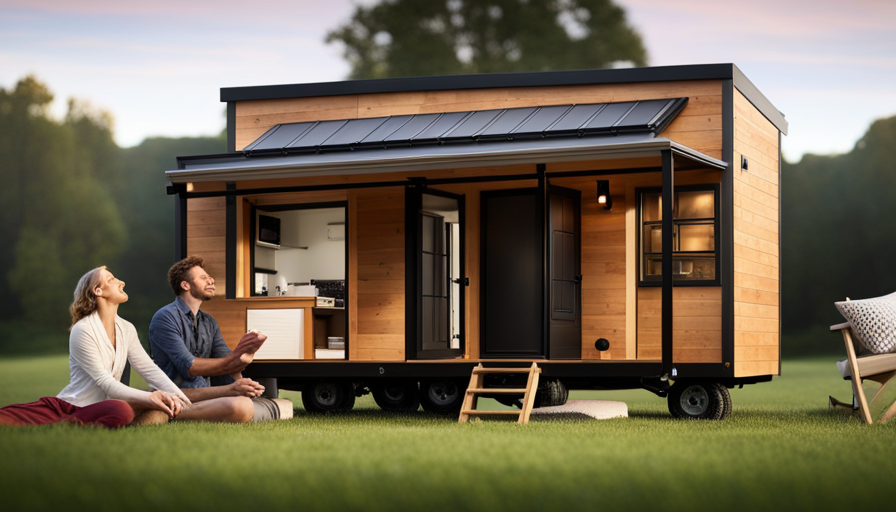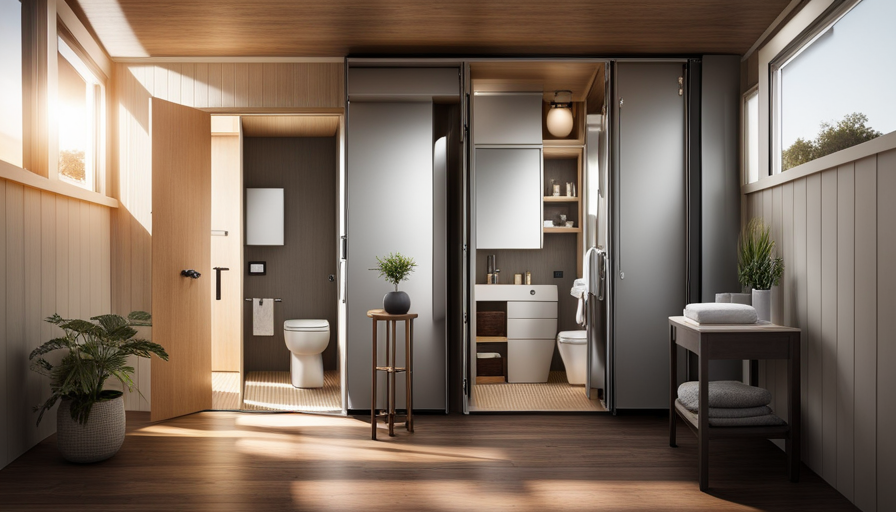Have you ever dreamed of living in a cozy sanctuary, where simplicity reigns and clutter is a thing of the past? If so, a tiny house might be just what you’re seeking. These small homes have gained popularity recently, offering a minimalist lifestyle choice and a more affordable housing option.
But just how much does a tiny house cost? Well, that’s what we’re here to explore. In this article, we will delve into the factors that impact tiny house prices, provide an average price range, and offer cost-saving tips for building or buying a tiny house. Additionally, we will discuss financing options and highlight hidden costs to be aware of.
Finally, we will examine the pros and cons of living in a tiny house, helping you make an informed decision about whether this lifestyle is right for you. So, if you’re ready to embark on a journey of simplicity and minimalism, let’s dive in and discover how much a tiny house might cost you.
Key Takeaways
- Factors impacting tiny house prices include size, materials, craftsmanship, location, and amenities.
- High-quality materials and intricate detailing can increase the cost of a tiny house.
- Additional costs such as permits, land purchase, and utility connections should be considered.
- Cost-saving tips include using salvaged/recycled materials, simplifying design/layout, and negotiating with builders/sellers.
Factors that Impact Tiny House Prices
If you’re looking to buy a tiny house, there are several factors that will have an impact on its price. Considering these factors is essential to finding the best deal and determining if a tiny house is the right choice for you.
One of the main factors influencing the price of a tiny house is its size. Generally, the smaller the house, the lower the cost. Additionally, the type of materials used and the level of craftsmanship can greatly affect the price. For example, high-quality materials and intricate detailing can increase the cost significantly.
Another factor to consider is the location where the tiny house will be placed. Depending on the area, there may be additional costs associated with permits, land purchase, or utility connections.
Lastly, the amenities and features inside the tiny house will also impact the price. Luxuries like a full kitchen, bathroom, or custom-built furniture can drive up the cost. When considering the average cost of a tiny house, it’s important to weigh these factors and explore cost-effective options.
Transitioning into the subsequent section, let’s now delve into the average price range for tiny houses.
Average Price Range for Tiny Houses
When considering the average price range for tiny houses, it’s important to take into account various factors. These factors include the choice between pre-built and DIY options, the level of basic versus luxury features, and the additional costs that may come into play.
Pre-built tiny houses tend to have higher upfront costs but can save time and effort. On the other hand, DIY options can be more cost-effective but require significant time and skill.
Additionally, the level of luxury features, such as high-end finishes or custom designs, can greatly impact the overall price. It is also essential to consider additional costs such as permits and utilities. These expenses can add up and should be factored into the budget.
Pre-built vs. DIY Options
While considering the cost of a tiny house, it’s important to weigh the options between pre-built and DIY alternatives.
Pre-built tiny houses have several advantages. Firstly, they save time and effort as they come fully constructed and ready to move in. Additionally, they often have warranties and professional craftsmanship, ensuring a high-quality build.
On the other hand, DIY tiny houses present their own set of challenges. Building a tiny house from scratch requires extensive knowledge in construction, design, and zoning regulations. It also demands a significant amount of time and energy. However, DIY options offer the flexibility to customize the tiny house according to personal preferences and can be more cost-effective for those with construction skills.
Moving forward, it’s vital to consider the options for basic vs. luxury features in a tiny house, as they can greatly impact the overall cost and lifestyle.
Basic vs. Luxury Features
Consider splurging on luxury features for your tiny abode to create a truly extravagant and opulent living experience. Adding these luxury amenities to your tiny house may increase the overall cost, but the benefits and comfort they provide are well worth it.
Here is a breakdown of the cost for some popular luxury features:
-
High-end kitchen appliances: Investing in top-of-the-line appliances can elevate your cooking experience and make your tiny kitchen feel more luxurious. Expect to spend around $5,000 to $10,000 for high-quality appliances.
-
Spa-like bathroom: Transform your tiny bathroom into a spa oasis with features like a rainfall shower, heated floors, and a luxurious bathtub. Budget around $3,000 to $8,000 for these upgrades.
-
Smart home technology: Automating your tiny house with smart devices can enhance convenience and comfort. From voice-controlled lighting to automated temperature control, expect to spend $2,000 to $5,000 on smart home features.
-
Custom furniture and fixtures: Investing in custom-made furniture and fixtures can maximize the use of space and create a unique, high-end look. Prices can vary greatly depending on the materials and design, but budget around $3,000 to $10,000 for these custom additions.
While these luxury features can significantly increase the cost of your tiny house, they can also make it a truly luxurious and comfortable home. It’s important to consider these additional costs when planning your budget, including permits, utilities, and other necessary expenses.
Additional Costs to Consider (e.g., permits, utilities)
Adding luxury features to your tiny abode may bring a sense of opulence, but it’s crucial to account for additional expenses such as permits and utilities. When building or buying a tiny house, it’s important to consider the costs associated with permits and zoning regulations.
Depending on your location, you may need to obtain permits for construction, which can vary in price. Additionally, you’ll need to adhere to zoning regulations to ensure your tiny house meets all requirements. These costs can add up quickly and should be factored into your budget when considering luxury features for your tiny house.
Furthermore, don’t forget about the ongoing costs of utilities such as water, electricity, and sewage. It’s essential to research and understand these additional expenses to avoid any surprises down the road.
Transitioning into the next section, let’s explore some cost-saving tips for building or buying a tiny house.
Cost-saving Tips for Building or Buying a Tiny House
When it comes to building or buying a tiny house, there are several cost-saving tips that can help you stay within your budget.
One way to save money is by utilizing salvaged or recycled materials for construction. By repurposing items such as doors, windows, and flooring, you can significantly reduce your expenses.
Additionally, simplifying the design and layout of your tiny house can also help cut costs. By minimizing the number of walls, stairs, and complicated features, you can save both time and money.
Lastly, don’t be afraid to negotiate with builders or sellers. You may be able to get a better price or additional perks by negotiating for things like discounted materials or free upgrades.
Utilizing Salvaged or Recycled Materials
You can save money and give your tiny house a unique charm by using salvaged or recycled materials – one man’s trash is another man’s treasure! Upcycling materials and repurposing resources not only reduces waste but also adds character to your tiny house.
There are countless possibilities when it comes to salvaged materials. Old barn wood can be transformed into beautiful flooring or siding, while antique doors and windows can bring a touch of history to your tiny home. Additionally, reclaimed plumbing fixtures and light fixtures can add a vintage vibe.
By incorporating salvaged materials, you not only save money but also contribute to a more sustainable lifestyle.
In the next section about simplifying design and layout, we will explore how to make the most of your tiny space while maintaining functionality and style.
Simplifying Design and Layout
To truly maximize the potential of your small living space, simplify the design and layout for a more functional and stylish experience. When it comes to designing a tiny house, every inch counts.
Here are some simplified design tips to help you make the most of your limited space:
-
Multi-functional furniture: Invest in pieces that serve multiple purposes, such as a sofa that can be converted into a bed or a dining table that doubles as a workspace.
-
Clever storage solutions: Utilize vertical space by installing shelves or cabinets that go all the way up to the ceiling. Use under-bed storage or built-in drawers to keep your belongings organized and out of sight.
By maximizing space efficiency through these design choices, you can create a tiny house that feels spacious and comfortable.
Transitioning into the next section about negotiating with builders or sellers, it’s important to consider these design elements when discussing pricing and options.
Negotiating with Builders or Sellers
Negotiating with builders or sellers can be a crucial step in creating a functional and stylish living space. When it comes to negotiating with builders, it’s important to have a clear understanding of your budget and desired specifications.
Researching the market and comparing prices from different builders can provide you with leverage during negotiations. Additionally, consider asking for discounts or incentives such as free upgrades or waived fees.
Another tip for finding reputable builders is to ask for referrals from friends, family, or local tiny house communities. Reading online reviews and checking the builder’s credentials can also help ensure their reliability.
By using these negotiating strategies and finding reputable builders, you can create a solid foundation for your tiny house project.
As we move on to discussing financing options for tiny houses, it’s important to explore various ways to fund your project without breaking the bank.
Financing Options for Tiny Houses
Consider exploring different financing options available for tiny houses, as they can provide you with the flexibility to turn your dream of owning a cozy and sustainable home into a reality.
When it comes to financing a tiny house, there are a few options to consider. One option is to look into tiny house loan options. These loans are specifically designed for those looking to purchase or build a tiny house and can provide you with the necessary funds to make your dream a reality.
Another option to consider is crowdfunding for tiny houses. Crowdfunding platforms have become increasingly popular for people looking to finance their tiny house projects. By creating a campaign and sharing your vision with others, you may be able to gather financial support from friends, family, or even strangers who believe in your dream.
It’s important to carefully research and consider the terms and conditions of any financing option you choose, as well as the interest rates and repayment terms. By taking the time to explore different financing options, you can ensure that you find the best fit for your individual needs and budget.
Moving forward, it’s crucial to be aware of the hidden costs associated with owning a tiny house.
Hidden Costs to be Aware of
Beware, for within the enchanting realm of your petite sanctuary lies a realm of hidden expenses waiting to reveal themselves. While the allure of a tiny house is undeniable, it is crucial to be aware of the hidden fees and unexpected expenses that may arise along the way.
These additional costs can quickly add up and impact your overall budget. One of the hidden fees to be mindful of is land expenses. Finding an ideal location for your tiny house may require purchasing or leasing land, which can be a significant expense depending on the area. Additionally, you may need to invest in utility hookups, such as water, electricity, and sewage, which can also come with unexpected costs.
Maintenance and repairs are another aspect often overlooked. As with any home, tiny houses require regular upkeep and occasional repairs. The smaller size may give the illusion of lower maintenance, but the reality can be quite different. It is important to budget for these expenses to avoid any surprises down the road.
Transitioning to the subsequent section about the pros and cons of living in a tiny house, it is essential to weigh the hidden costs against the benefits. While there are indeed additional expenses to consider, the advantages of living in a tiny house can outweigh these monetary concerns.
Pros and Cons of Living in a Tiny House
Living in a tiny house offers numerous financial benefits, such as lower utility bills and reduced debt. With limited space and minimal storage, there are also lifestyle considerations to take into account. However, one of the most significant advantages of living in a tiny house is the positive environmental impact it can have, as it contributes to a reduced carbon footprint.
Financial Benefits (e.g., lower utility bills, reduced debt)
Save money and reduce your financial burdens by opting for a tiny house, with lower utility bills and less debt. Living in a tiny house can significantly lower your expenses, allowing you to achieve greater financial independence. Here are five financial benefits of living in a tiny house:
-
Lower utility bills: With a smaller space to heat, cool, and light, your monthly utility bills will be significantly reduced.
-
Reduced debt: The cost of purchasing or building a tiny house is often much lower than a traditional home, allowing you to minimize or eliminate mortgage debt.
-
Lower maintenance costs: Tiny houses require less maintenance, resulting in lower repair and upkeep expenses.
-
Lower property taxes: The value of a tiny house is typically lower than that of a larger home, resulting in lower property tax payments.
-
Increased savings: By reducing your expenses, you can allocate more money towards savings and investments, helping you build wealth over time.
Considering these financial benefits, it’s important to also take into account lifestyle considerations, such as limited space and minimal storage, when deciding if a tiny house is right for you.
Lifestyle Considerations (e.g., limited space, minimal storage)
Imagine a cozy home where every nook and cranny is utilized, allowing for a simplified and clutter-free lifestyle. This is the reality for those who choose to live in a tiny house.
However, it’s important to consider the lifestyle considerations that come with limited space and minimal storage. In a tiny house, every square inch counts, so it’s crucial to be mindful of what possessions are truly essential. Downsizing and decluttering become necessary habits to maintain a comfortable living environment. Creative storage solutions, such as utilizing vertical space and multifunctional furniture, can help maximize the limited space available.
Living in a tiny house requires a mindset shift towards minimalism and intentional living. It may not be suitable for those who value having ample storage or enjoy collecting various possessions.
Transitioning to the subsequent section about the environmental impact of tiny houses, it’s worth noting that their compact size contributes to a reduced carbon footprint.
Environmental Impact (e.g., reduced carbon footprint)
With its compact size and efficient design, a tiny house leaves a smaller ecological footprint on the environment. This sustainable living option not only promotes reduced energy consumption but also offers numerous environmental benefits. Here are five key ways in which tiny houses contribute to a greener lifestyle:
-
Efficient insulation: Tiny houses are designed to maximize insulation, reducing the need for excessive heating or cooling. This helps conserve energy and minimizes environmental impact.
-
Renewable energy sources: Many tiny house owners choose to incorporate renewable energy systems such as solar panels or wind turbines. These sustainable energy sources further reduce reliance on fossil fuels.
-
Water conservation: Tiny houses often employ innovative water-saving features like low-flow fixtures, rainwater collection systems, and composting toilets. These practices help conserve water, a precious resource.
-
Minimal material usage: Constructing a tiny house requires fewer materials compared to traditional homes. This reduces the demand for resources and minimizes waste.
-
Reduced carbon emissions: Tiny houses have a smaller carbon footprint due to their reduced energy needs and efficient design. This makes them a sustainable choice for environmentally conscious individuals seeking a smaller ecological impact.
Tiny houses offer a practical and sustainable solution for reducing energy consumption and living a more environmentally friendly lifestyle.
Frequently Asked Questions
How much does it cost to maintain a tiny house?
Maintaining a tiny house costs significantly less than a traditional home. The cost comparison is clear, with lower expenses for utilities, repairs, and insurance. However, it’s important to weigh the pros and cons of tiny living before making a decision.
Are there any regulations or permits required for building or parking a tiny house?
Yes, there are regulations and permits required for building and parking a tiny house. These vary depending on location, but typically involve zoning, building codes, and permits for utilities and occupancy.
What are some common challenges faced by tiny house owners?
Challenges faced by tiny house owners include limited space, finding suitable parking, and dealing with zoning regulations. However, the benefits of living in a tiny house, such as affordability and simplicity, often outweigh these challenges.
Can I rent or lease a tiny house instead of buying one?
Yes, you can rent or lease a tiny house instead of buying one. Renting options provide flexibility and affordability, allowing you to experience the advantages of tiny living without the long-term commitment or financial investment.
Are there any specific insurance requirements for tiny houses?
Insurance coverage for tiny houses is essential, considering their size and mobility. Options include liability coverage, property coverage, and even coverage for transporting the house. It’s crucial to assess your specific needs and consult with an insurance professional.
Conclusion
In conclusion, when considering the cost of a tiny house, it’s important to take into account various factors that can influence the overall price.
While the average price range for these compact dwellings can vary, there are ways to save money during the building or buying process. Additionally, exploring financing options can make owning a tiny house more attainable. However, it’s crucial to be aware of hidden costs that may arise.
Ultimately, living in a tiny house has its pros and cons, but it can offer a unique and charming living experience.
Hi, I’m Emma. I’m the Editor in Chief of Tiny House 43, a blog all about tiny houses. While tree houses are often associated with childhood, they can be the perfect adult retreat. They offer a cozy space to relax and unwind, surrounded by nature. And since they’re typically built on stilts or raised platforms, they offer stunning views that traditional homes simply can’t match. If you’re looking for a unique and romantic getaway, a tree house tiny house might just be the perfect option.
